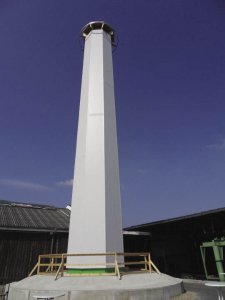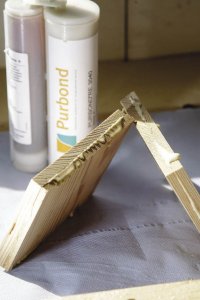
Using wood for a 100m tower can save about 300 tons of sheet steel and increase hub heights to 200m.
More steel is being used in the wind energy industry than in shipbuilding, according to some estimates. The 20% forecasted annual growth in wind will further increase steel consumption and drive its price up. One company suggests the industry might be better served using a sustainable raw material, wood, for turbine towers. This alternative can do the same job as steel and possibly better. One wooden tower can reach hub heights up to 200m, says its design firm. The result: increased revenues from wind power.
Using wood for a 100m tower can save about 300 tons of sheet steel, says Henkel. The company has worked closely with German-based TimberTower GmbH. For onshore wind, there is a need for alternatives to the commonly used tubular-steel towers. No previous concept, says the company, whether concrete towers, steel girder masts, or hybrid towers made from concrete and steel have been able to show long-term promise. Conventional tubular-steel towers require an immense amount of maintenance to protect against corrosion. Henkel says wood is an attractive alternative for wind power. The key advantages include protection against corrosion, ease of transportation, lower costs than steel, and reduction in CO2 emissions. And the company ensures a lifecycle of 20 years.
The TimberTower is manufactured as an assembly of glued, laminated timber panels, and surface components. No dowels, nails, screws, or bolts are used to hold this timber construction together. Workers assemble the tower on-site into a closed, hollow body with a hexagonal, octagonal, or dodecagonal cross section. The base measures 7.0 x 7.0m and the top, 2.90 x 2.90m. A waterproofing membrane is placed on the wood to protect it from the elements. The segments are transported in 40ft. containers. The fasteners are integrated in the tower’s individual components, along with a ladder and lift system. Round, steel adapters connect the nacelle to the tower. The base has a mass and diameter similar to tubular steel towers. The wooden tower weighs about 90 metric tons, with the top-mounted nacelle and rotor, adding another 100 tons.

TimberTower says its design has greater stress resistance, can be built significantly higher, and is 20 to 30% cheaper to make than steel towers.
“This wind tower is one of the most innovative projects in the history of wood,” says Walter Stampfli, General Manager of Purbond. It is already looking like it won’t be the last, because the expertise that Henkel has gained from this project is getting attention in the relevant engineering communities. “We have the most advanced adhesives for the manufacture of load-bearing timber elements and constructions able to meet the standard specifications applicable in almost all countries,” says Stampfli, alluding to the development results achieved over the last two years. Back in 2008, the first eight-storey timber building was constructed in London with Purbond adhesives, while the first 10-storey high-rise was built in Melbourne. And in Canada, a construction project involving a 30-storey building is also in the offing.
“The way we see it, this tower offers nothing but advantages,” says TimberTower’s General Manager, Holger Giebel. “It has greater stress resistance, can be built significantly higher and is 20 to 30% cheaper to make.
The Purbond adhesive joints had to prove their suitability. Each one has received a certificate of worthiness from the DIBt, Germany’s institute of building technology.” A TimberTower holding a 1.5 MW wind turbine could supply electricity to around 150 households in Germany’s Lower Saxony.

The Purbond adhesive joints had to prove their suitability. Each one has received a certificate of worthiness from the DIBt, Germany’s institute of building technology.
What’s more, the potential raw timber in Germany is about 78 million cubic meters per year for the next 40 years. At present, only about 55 million cubic meters of wood per year are being felled in Germany. Taking into account residual wood and firewood, this amounts to an estimated annual collection of about 64 million cubic meters of wood from the forest. This shows that considerably more wood could be used without damaging the sustainability of the forests.
Partners from Germany and Austria manufacture the wooden and surface elements. A PEFC certificate held by wood suppliers guarantees that the raw material used originates from ecologically, economically and socially responsible forest management. WPE
Filed Under: News, Towers





Corrosion should not be an issue moving forward. CorrLine International has a new surface preparation process that removes the microscopic contaminants that cause corrosion. The process not only eliminates those elements but improves coating adhesion significantly. Where used previously there have been no reported coating failures. The process streamlines current surface preparation processes, is more environmentally friendly, safer and coating independent.
Quite an interesting read! Protection with regard to industrial coating is mandatory and thus proper care should be given in taking necessary steps to avoid danger and damages